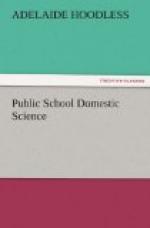FOOTNOTE:
[4] See Vegetables, Chap. VII.
CHAPTER III.
Nutrition.
It is not within the scope of this book to deal with the science of nutrition; but a few general principles may be given which concern the effect upon the system of the different classes of food. Animal food requires a considerable quantity of oxygen for its complete combustion. Meat in general has a more stimulating effect upon the system and is more strengthening than vegetable food. There is, however, a tendency to eat too much meat, and when its effects are not counter-balanced by free outdoor exercise, it causes biliousness and sometimes gout and other troubles. Albuminous foods can be eaten longer alone without exciting loathing than can fats, sugars or starches. A carbonaceous diet taxes the excretory organs less than animal food. Meat is not necessary to life. Nitrogenous food man must have, but it need not be in the form of meat. The estimate commonly given is, that meat should occupy one-fourth and vegetable food three-fourths of a mixed diet, but in many cases the meat eaten is much in excess of this allowance. The proper association of different foods always keeps healthy people in better condition; there are times, however, when it may be necessary to abstain from certain articles of diet. It may be well to bear in mind, that the protein compounds can do the work of the carbohydrates and fats in being consumed for fuel, but the carbohydrates and fats cannot do the work of protein in building and repairing the tissues of the body. As already stated, a mixed diet is the only rational one for man. An exclusively vegetable diet, while it may maintain a condition of health for a time, eventually results in a loss of strength and power to resist disease. Therefore it is necessary to understand the approximate value of each class of food in arranging the daily dietary.
CHAPTER IV.
Food and Economy.
It has been stated that “a quart of milk, three-quarters of a pound of moderately lean beef, and five ounces of wheat flour contain about the same amount of nutritive material;” but we pay different prices for them, and they have different values for nutriment. The milk comes nearest to being a perfect food. It contains all the different kinds of nutritive materials that the body requires. Bread made from wheat flour will support life. It contains all the necessary ingredients for nourishment, but not in the proportion best adapted for ordinary use. A man might live on beef alone, but it would be a very one-sided and imperfect diet. Meat and bread together make the essentials of a healthful diet. In order to give a general idea of food economy, it will be necessary to deal briefly with the functions of the various food principles. As our bodies contain a great




